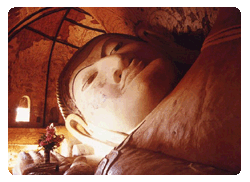|
Mesenteric Infraction
A disease that matches the described symptoms - accompanied by acute abdominal
pain and the passage of blood, commonly found among elderly people and triggered
by a meal - is mesenteric infarction, caused by an obstruction of the blood vessels
of the mesentery. It is lethal.
Acute mesenteric ischaemia (a reduction in
the blood supply to the mesentery) is a grave condition with a high rate of mortality.
The mesentery is a part of the intestinal wall that binds the whole intestinal
tract to the abdominal cavity. An infarction of the vessels of the mesentery normally
causes the death of the tissue in a large section of the intestinal tract, which
results in a laceration of the intestinal wall.
This normally produces severe
pain in the abdomen and the passage of blood. The patient usually dies of acute
blood loss.
This condition matches the information given in the sutta. It
is also confirmed later when the Buddha asked Ananda to fetch some water for him
to drink, indicating intense thirst. As the story goes, Ananda refused, as he
saw no source for clean water. He argued with the Buddha that the nearby stream
had been muddied by a large caravan of carts. But the Buddha insisted he fetch
water anyway.
A question arises at this point: Why did the Buddha not
go to the water himself, instead of pressing his unwilling attendant to do so?

The answer
is simple.
The Buddha was suffering from shock caused by severe blood
loss. He could no longer walk, and from then to his death bed lie was most likely
carried on a stretcher. If this is was indeed the situation, the sutta remains
silent about the Buddha's travelling to his deathbed possibly because the author
felt that it would be an embarrassment for the Buddha. Geographically, we know
that the distance between the place believed to be the house of Cunda and the
place where the Buddha died was about 15 to 20 kilometres. It is not possible
for a patient with such a grave illness to walk such a distance. More likely,
what happened was that the Buddha was carried on a stretcher by a group of monks
to Kusinara (Kushinagara) It remains a point of debate whether the Buddha really
determined to pass away at this city, presumably not much larger than a town.
From the direction of the Buddha's journey, given in the Sutta, he was moving
north from Rajagaha. It is possible that he did not intend to die there, but in
the town where he was born, which would have taken a period of three months to
reach.
From the sutta, it is clear that the Buddha was not anticipating his
sudden illness, or else he would not have accepted the invitation of his host.
Kusinara was probably the nearest town where he could find a doctor to take care
of him. It is not difficult to see a group of monks hurriedly carrying the Buddha
on a stretcher to the nearest town to save his life.
Before passing away
the Buddha told Ananda that Cunda was not to be blamed and that his death was
not caused by eating Sukaramaddava. The statement is significant.
The
meal was not the direct cause of his death. The Buddha knew that the symptom was
a repeat of an experience he had a few months earlier, the one which had almost
killed him. Sukaramaddava, no matter the ingredients or how it was cooked, was
not the direct cause of his sudden illness Progression
of the disease Mesenteric infarction is a
disease commonly found among elderly people, caused by the obstruction of the
main artery that supplies the middle section of the bowel - the small intestine
with blood. The most common cause of the obstruction is the degeneration of the
wall of the blood vessel, the superior mesenteric artery, causing severe abdominal
pain, also known as abdominal angina.
Normally, the pain is triggered
by a large meal which requires a higher flow of blood to the digestive tract As
the obstruction persists, the bowel is deprived of its blood supply, which subsequently
leads to an infarction, or gangrene of a section of the intestinal tract.This
in turn results in a laceration of the intestinal wall profuse bleeding into the
intestinal tract, and then bloody diarrhoea. The disease gets worse as the liquid
and content of the intestine oozes out into the peritoneal cavity, causing peritonitis
or inflammation of the abdominal walls.
This is already a lethal condition
for the patient, who often dies due to the loss of blood and other fluid. If it
is not corrected by surgery, the disease often progresses to septic shock due
to bacterial toxins infiltrating the blood stream.
Conclusion
|